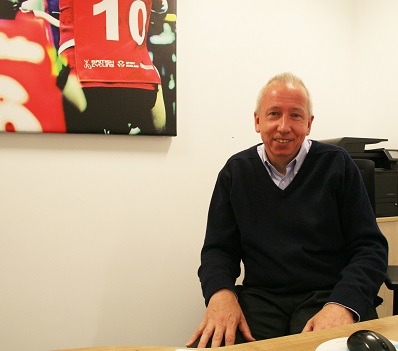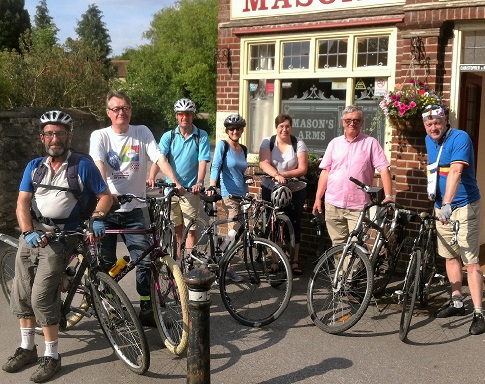
John Mills: facilities strategy is an essential element of the future of British cycling
Where we ride: the essentials of growing a sport
Continuing its conversation with John Mills, the Leisure Review discussed the thinking behind British Cycling’s facilities strategy and why it’s about a bit more than just the bike.

John Mills: facilities strategy is an essential element of the future of British cycling
Like most sport, cycling is essentially a simple proposition: one bike each, first to the finish line wins.
Or the fastest. Or the first team. Or first two on a tandem. Indoors or out. Tarmac or mud.
And like most sports, once you get away from the very simplest formats – the playground or park scenario – things begin to get a lot more complicated very quickly, particularly if you are trying to get more people to take part or help to improve the performance of those who do.
The first part of our conversation with John Mills, British Cycling’s director of coaching, education and development, considered the sports development process from the perspective of one of the UK’s most successful national governing bodies of sport, including the remit of a governing body, the various roles of the volunteer and coaching workforce, the contribution of the schools, clubs and regions, and the importance of funding to make the whole system viable over the long term.
The next part of our discussion moved on to facilities and how the provision of, and access to, places to ride a bike, whether to compete or for the sheer joy of it, shapes the development of a sport and the opportunities it can offer.
The popular image of cycling participation is of someone getting their bike out of the shed, squeezing the tyres knowingly and heading off for a ride in the countryside. However, as we saw with the building of the Manchester velodrome (qv part one of this conversation in the last issue) facilities can have a profound effect on the development of a sport.
“Facilities is a huge issue for us,” Mills says. “Again, I have to say that the support from Sport England has been fantastic. We got the biggest capital award of any governing body and part of that is we have very few facilities. While we would always want to be able to ride and race on the public highway, there’s an increasing pressure on the public highway and if you’re getting new people, including lots of young people, coming into the sport they actually want somewhere safe to start. Likewise, we also want to be able to organise competition on a local level to enable riders to develop their skills.
“We’ve been doing some work on our facilities strategy and it was suggested that we look at other sports’ facilities strategies. Looking at Athletics they had nearly 300 synthetic athletics tracks in 2012 and at the time we had 17 closed-road circuits, 3 indoor and 9 outdoor velodromes. The average age of an outdoor velodrome in this country is over 50 years, and we’ve built three in the last three years so that average is probably closer to 80-plus. So there is definitely a need for facilities in terms of developing performance, otherwise it’s like trying to train Olympic swimmers without a swimming pool.”
British Cycling’s facilities strategy is supported by £7 million from Sport England, the biggest capital grant of any sport and the plan is to work with partners among local authorities or educational establishments to provide match funding. A fund of £14 million would build, British Cycling estimates, around 30 facilities.
Developing this number of new facilities would represent a significant step for cycling development and the focus is on outdoor circuits rather than indoor velodromes. Olympic-standard velodromes have been – and will be – an integral part of the development of cycling in the UK but they are expensive to build; the most recent velodrome in Derby came in at around £29 million. In contrast a closed-road circuit of a kilometre can be delivered for about £600,000.
“In the greater scheme of things, a closed-road circuit that lasts for 15 years pretty much maintenance-free for that amount of money is actually pretty good value for a local authority,” says Mills. “And it can be used by cyclists, triathletes, runners and wheelchair athletes. It has multiple uses and can be used by Olympic performers through to anyone learning to ride a bike. So a circuit like that is very versatile and actually represents good value for money.”
In the first year of British Cycling’s Whole Sport Plan six closed-road circuits were developed, with another three in year two. Initial scoping suggests that there are some 50 sites around the UK where such cycle circuits might work and analysis of the existing sites is beginning to demonstrate a good case for investment. A recently completed circuit in Torbay had around 10,000 users in its first year, which over a period of 20 years equates to approximately £3.00 per user.. The circuit in Middlesbrough, which has been open for a few years, currently has 16,000 users, taking the cost per user down to £1.87. With some more established circuits having over 20,000 users per annum, taking the cost down to less than £1.50 per user. The argument being that this offers good value, particularly when the longevity of the facility is taken into account. While the investment required is still sizeable, it compares favourably with the costs associated with a new sports hall or swimming pool.
“So we’re saying that there’s an opportunity here,” Mills explains. “What if we were to put the whole of the population within an hour of a closed-road circuit? If you’re an hour a way you’d probably go there to get a good experience; and if it’s got lighting you can use it throughout the year.
“I’ve been brought up on traditional sports development and we always used to say that if the world ended tomorrow athletics clubs would still train on Tuesday and Thursday nights and Saturday morning. That’s because you’ve got an athletics facility and that’s where you go to train and compete. So to make cycling a bit more of a facility-based sport – where as a club you have a home, a base at a facility – that makes a lot of sense. For us facilities are very important to the future of what we’re doing – working to develop both participation and performance pathways.”
The closed-road circuit in Bath now has seven different clubs using it so such a model can work and even though cycling is a multi-disciplinary sport, the facility-based approach is still applicable. Mills offers a BMX track in Burgess Park in London by way of example. In the first year it had 11,000 users, which equates to a cost of around £2.50 per user. While a BMX track might need a bit more upkeep than a road circuit and is more sensitive to location, its usage figures could match those of a road circuit.
“That track has also helped to get to people who are quite hard to reach in terms of participating in sport and physical activity,” Mills says. “And at the other end it has also highlighted talented performers. So this is a facility that can do the hard-to-reach stuff, regular club activity, talent identification and performance improvement across the spectrum. And closed-road circuits can do the same, offering places to ride, train and race. Up to now we haven’t had that tradition and, while we’d always want to retain the right to race on the public highway, the new facilities are starting to make an impact, particularly in terms of the increased participation.”
Our conversation is taking place in in the velodrome where the British Cycling revolution began. Could road circuits be the start of another revolution? “Well, yes, I think the road circuit delivers the best rate of return. But also in terms of a training venue, it is probably a lot more versatile than an outdoor velodrome. Of course, I don’t want to do a disservice to track cycling but if you were a recreational cyclist and you wanted to learn to improve your skills a velodrome wouldn’t be your first choice. A closed road circuit is traffic-free, pretty safe, and you could actually ride on your own or with friends or join a club and be coached.”
With the profile of British riders as high as ever, the elite end of the development pyramid seems to be delivering grand tour wins and world championships with some consistency. What difference does a yellow jersey or a world champion’s rainbow bands make to the job of developing British cycling?
“Oh, it’s massive. It really is. I often hear cycling being called the new golf – where people might once have bought a new set of golf clubs, thanks to our cycling superstars such as Sir Bradley Wiggins, Chris Froome and Lizzie Armitstead they’re now buying a bike. It’s also very important to young people thinking about their performance, wanting to follow their heroes, wanting to be part of something that is popular. When I was a kid and into cycling we bought the jerseys of the top riders and to have those now being British riders and Olympic heroes has been absolutely huge.
“But to be able to capitalise on that has been critical. You don’t want to have a British Tour winner and not be ready for it. I remember years ago – I’m showing my age now – Frank Dick was the director of performance in athletics, their head coach. After a major championships in which the GB team did really well he said, ‘If you want to get involved in athletics go down to your local club on a Tuesday night and there’ll be someone there to coach you.’ We had a load of people turn up and we just weren’t ready. So what we’ve tried to do when we’ve had major events, whether it’s the Tour de France or the Olympics, is to work with our Go Ride clubs and gear up for this so we can run some activities the weekend after that event and attract people in. So when everybody sees Brad or Chris winning the tour and rings up, we’re here ready to take the phone calls and we’re able to say your local club is running an event this Saturday starting at ten o’clock.”
Mills concedes that it has been a lesson painfully learned for a lot of sports over the years but one that British Cycling has taken to heart: “Personally I learned that lesson after Sydney so by Athens we were ready; at Beijing we were ready; London we were ready; Tour de France last year we were ready; Commonwealth Games we were ready. So all the time we try to put those promotional programmes in place to get more young people into the sport. A potential barrier is that if you go along and it’s a local club night everyone knows each other you might feel a bit uncomfortable but when it’s a special event and people are ready to welcome you, that puts everyone in a better position.”
With British riders having won three of the last four Tours and Lizzie Armistead currently turning out for her winter training rides in the world champion’s rainbow jersey, it is hard to imagine the sport of cycling in a better position, at least when it comes to the elite end of the development spectrum. With cycling arguably now more popular as a sport in the UK than ever before, participation continuing to grow and the bike as transport beginning to have a significant impact on our urban roads, it may be that the concept of an extended network of purpose-built facilities is about to have its time. It would certainly be interesting to see what impact it might have on the development process; and there will certainly be plenty of people hoping that one opens near them.
The first part of this interview was published in issue 79 of the Leisure Review.
The Leisure Review, February 2016
© Copyright of all material on this site is retained by The Leisure Review or the individual contributors where stated. Contact The Leisure Review for details.
![]() Download a pdf version of this article for printing
Download a pdf version of this article for printing

Rolling out: cycling participation is not necessarily about speed and Lycra

The right path: safe places to pedal are vital to the future of participation